英美文学专有名词术语解释
英美文学名词解释总结.doc
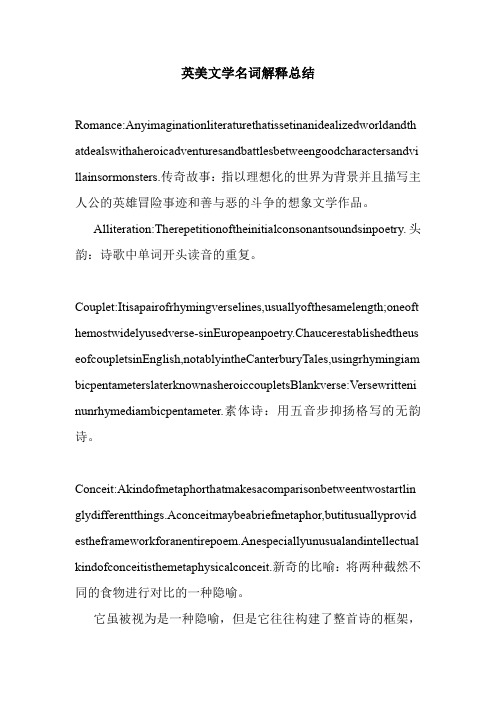
英美文学名词解释总结Romance:Anyimaginationliteraturethatissetinanidealizedworldandth atdealswithaheroicadventuresandbattlesbetweengoodcharactersandvi llainsormonsters.传奇故事:指以理想化的世界为背景并且描写主人公的英雄冒险事迹和善与恶的斗争的想象文学作品。
Alliteration:Therepetitionoftheinitialconsonantsoundsinpoetry.头韵:诗歌中单词开头读音的重复。
Couplet:Itisapairofrhymingverselines,usuallyofthesamelength;oneoft hemostwidelyusedverse-sinEuropeanpoetry.Chaucerestablishedtheus eofcoupletsinEnglish,notablyintheCanterburyTales,usingrhymingiam bicpentameterslaterknownasheroiccoupletsBlankverse:Versewritteni nunrhymediambicpentameter.素体诗:用五音步抑扬格写的无韵诗。
Conceit:Akindofmetaphorthatmakesacomparisonbetweentwostartlin glydifferentthings.Aconceitmaybeabriefmetaphor,butitusuallyprovid estheframeworkforanentirepoem.Anespeciallyunusualandintellectual kindofconceitisthemetaphysicalconceit.新奇的比喻:将两种截然不同的食物进行对比的一种隐喻。
英美文学名词解释整理版
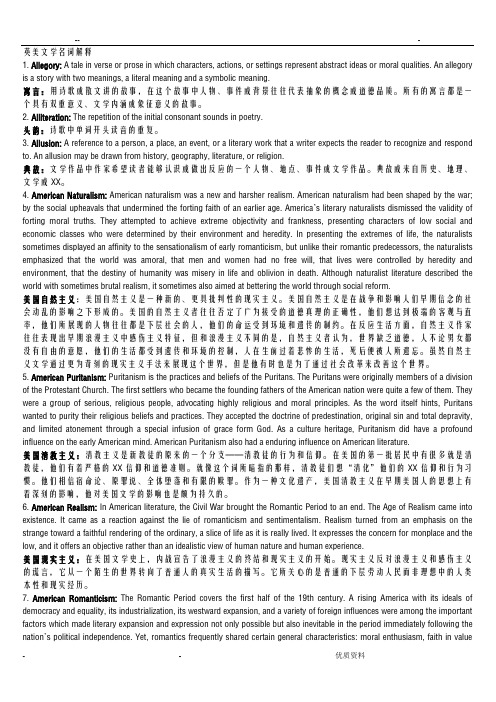
英美文学名词解释1. Allegory: A tale in verse or prose in which characters, actions, or settings represent abstract ideas or moral qualities. An allegory is a story with two meanings, a literal meaning and a symbolic meaning.寓言:用诗歌或散文讲的故事,在这个故事中人物、事件或背景往往代表抽象的概念或道德品质。
所有的寓言都是一个具有双重意义、文学内涵或象征意义的故事。
2.Alliteration: The repetition of the initial consonant sounds in poetry.头韵:诗歌中单词开头读音的重复。
3. Allusion: A reference to a person, a place, an event, or a literary work that a writer expects the reader to recognize and respond to. An allusion may be drawn from history, geography, literature, or religion.典故:文学作品中作家希望读者能够认识或做出反应的一个人物、地点、事件或文学作品。
典故或来自历史、地理、文学或XX。
4. American Naturalism: American naturalism was a new and harsher realism. American naturalism had been shaped by the war; by the social upheavals that undermined the forting faith of an earlier age. America’s literary naturalists dismissed the validity of forting moral truths. They attempted to achieve extreme objectivity and frankness, presenting characters of low social and economic classes who were determined by their environment and heredity. In presenting the extremes of life, the naturalists sometimes displayed an affinity to the sensationalism of early romanticism, but unlike their romantic predecessors, the naturalists emphasized that the world was amoral, that men and women had no free will, that lives were controlled by heredity and environment, that the destiny of humanity was misery in life and oblivion in death. Although naturalist literature described the world with sometimes brutal realism, it sometimes also aimed at bettering the world through social reform.美国自然主义:美国自然主义是一种新的、更具批判性的现实主义。
英美文学名词解释最全版
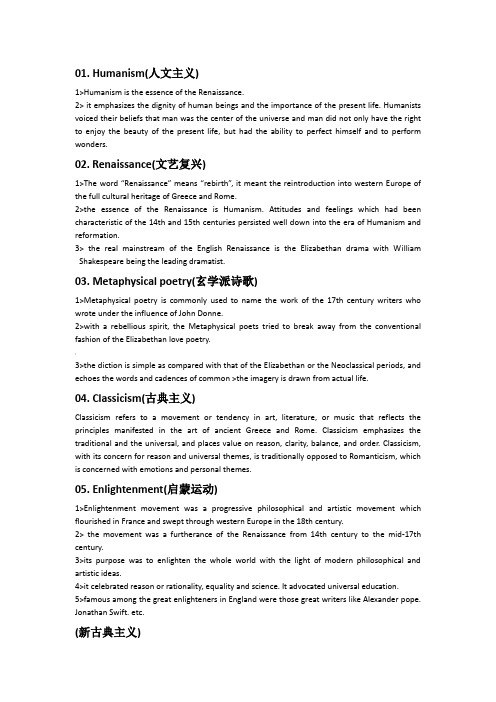
01. Humanism(人文主义)1>Humanism is the essence of the Renaissance.2> it emphasizes the dignity of human beings and the importance of the present life. Humanists voiced their beliefs that man was the center of the universe and man did not only have the right to enjoy the beauty of the present life, but had the ability to perfect himself and to perform wonders.02. Renaissance(文艺复兴)1>The word “Renaissance”means “rebirth”, it meant the reintroduction into western Europe of the full cultural heritage of Greece and Rome.2>the essence of the Renaissance is Humanism. Attitudes and feelings which had been characteristic of the 14th and 15th centuries persisted well down into the era of Humanism and reformation.3> the real mainstream of the English Renaissance is the Elizabethan drama with William Shakespeare being the leading dramatist.03. Metaphysical poetry(玄学派诗歌)1>Metaphysical poetry is commonly used to name the work of the 17th century writers who wrote under the influence of John Donne.2>with a rebellious spirit, the Metaphysical poets tried to break away from the conventional fashion of the Elizabethan love poetry.,3>the diction is simple as compared with that of the Elizabethan or the Neoclassical periods, and echoes the words and cadences of common >the imagery is drawn from actual life.04. Classicism(古典主义)Classicism refers to a movement or tendency in art, literature, or music that reflects the principles manifested in the art of ancient Greece and Rome. Classicism emphasizes the traditional and the universal, and places value on reason, clarity, balance, and order. Classicism, with its concern for reason and universal themes, is traditionally opposed to Romanticism, which is concerned with emotions and personal themes.05. Enlightenment(启蒙运动)1>Enlightenment movement was a progressive philosophical and artistic movement which flourished in France and swept through western Europe in the 18th century.2> the movement was a furtherance of the Renaissance from 14th century to the mid-17th century.3>its purpose was to enlighten the whole world with the light of modern philosophical and artistic ideas.4>it celebrated reason or rationality, equality and science. It advocated universal education.5>famous among the great enlighteners in England were those great writers like Alexander pope. Jonathan Swift. etc.(新古典主义)!1>In the field of literature, the enlightenment movement brought about a revival of interest in the old classical works.2>this tendency is known as neoclassicism. The Neoclassicists held that forms of literature were to be modeled after the classical works of the ancient Greek and Roman writers such as Homer and Virgil and those of the contemporary French ones.3> they believed that the artistic ideals should be order, logic, restrained emotion and accuracy, and that literature should be judged in terms of its service to humanity.07. The Graveyard School(墓地派诗歌)1>The Graveyard School refers to a school of poets of the 18th century whose poems are mostly devoted to a sentimental lamentation or meditation on life. Past and present ,with death and graveyard as themes.2>Thomas Gray is considered to be the leading figure of this school and his Elegy written in a country churchyard is its most representative work.08. Romanticism(浪漫主义)1>In the mid-18th century, a new literary movement called romanticism came to Europe and then to England.2>It was characterized by a strong protest against the bondage of neoclassicism, which emphasized reason, order and elegant wit. Instead, romanticism gave primary concern to passion, emotion, and natural beauty.3>In the history of literature. Romanticism is generally regarded as the thought that designates a literary and philosophical theory which tends to see the individual as the very center of all life and experience. 4> The English romantic period is an age of poetry which prevailed in England from 1798 to 1837. The major romantic poets include Wordsworth, Byron and Shelley.(09. Byronic Hero(拜伦式英雄)1>Byronic hero refers to a proud, mysterious rebel figure of noble origin.2> with immense superiority in his passions and powers, this Byronic Hero would carry on his shoulders the burden of righting all the wrongs in a corrupt society. And would rise single-handedly against any kind of tyrannical rules either in government, in religion, or in moral principles with unconquerable wills and inexhaustible energies.3> Byron’s chief contribution to English literature is his creation of the “Byronic Hero”10. Critical Realism(批判现实主义)1>Critical Realism is a term applied to the realistic fiction in the late 19th and early 20th centuries.2> It means the tendency of writers and intellectuals in the period between 1875 and 1920 to apply the methods of realistic fiction to the criticism of society and the examination of social issues.3> Realist writers were all concerned about the fate of the common people and described what was faithful to reality.4> Charles Dickens is the most important critical realist.11. Aestheticism(美学主义)~1>The basic theory of the Aesthetic movement--- “art for art’s sake” was set forth by a French poet, Theophile Gautier, the first Englishman who wrote about the theory of aestheticism was Walter Pater.2> aestheticism places art above life, and holds that life should imitate art, not art imitate life.3> According to the aesthetes, all artistic creation is absolutely subjective as opposed to objective. Art should be free from any influence of egoism. Only when art is for art’s sake, can it be immortal. They believed that art should be unconcerned with controversial issues, such as politics and morality, and that it should be restricted to contributing beauty in a highly polished style.4> This is one of the reactions against the materialism and commercialism of the Victorian industrial era, as well a s a reaction against the Victorian convention of art for morality’s sake, or art for money’s sake.美学运动的基本原则”为艺术而艺术”最初由法国诗人西奥费尔.高缔尔提出,英国运用该美学理论的第一人是沃尔特.佩特.美学主义崇尚艺术高于生活,认为生活应模仿艺术,而不是艺术模仿生活.在美学主义看来,所有的艺术创作都是绝对主观而非客观的产物.艺术不应受任何功利的影响,只有当艺术为艺术而创作时,艺术才能成为不朽之作.他们还认为艺术不应只关注一些热点话题如政治和道德问题,艺术应着力于以华丽的风格张扬美.这是对维多利亚工业发展时期物质崇拜的一种回应,也是向艺术为道德或为金钱而服务的维多利亚传统的挑战.Victorian period(维多利亚时期)1>In this period, the novel became the most widely read and the most vital and challenging expression of progressive thought. While sticking to the principle of faithful representation of the 18th century realist novel, novelists in this period carried their duty forward to criticism of the society and the defense of the mass.2> although writing from different points of view and with different techniques, they shared one thing in common, that is, they were all concerned about the fate of the common people. They were angry with the inhuman social institutions, the decaying social morality as represented by the money-worship and Utilitarianism, and the widespread misery, poverty and injustice.3>their truthful picture of people’s life and bitter and strong criticism of the society had done much in awakening the public consciousness to the social problems and in the actual improvement of the society.4> Charles Dickens is the leading figure of the Victorian period.—13. Modernism(现代主义)1>Modernism is comprehensive but vague term for a movement , which begin in the late 19th century and which has had a wide influence internationally during much of the 20th century.2> modernism takes the irrational philosophy and the theory of psycho-analysis as its theoretical case.3> the term pertains to all the creative arts. Especially poetry, fiction, drama, painting, music and architecture.4> in England from early in the 20th century and during the 1920s and 1930s, in America from shortly before the first world war and on during the inter-war period, modernist tendencies were at their most active and fruitful.5>as far as literature is concerned, Modernism reveals a breaking away from established rules, traditions and conventions. fresh ways of looking at man’s position and function in the universe and many experiments in form and style. It is particularly concerned with language and how to use it and with writing itself.14. Stream of consciousness(意识流)(or interior monologue)In literary criticism, Stream of consciousness denotes a literary technique which seeks to describe an individual’s point of view by giving the written equivalent of the character’s tho ught processes. Stream of consciousness writing is strongly associated with the modernist movement. Its introduction in the literary context, transferred from psychology, is attributed to May Sinclair. Stream of consciousness writing is usually regarded as a special form of interior monologue and is characterized by associative leaps in syntax and punctuation that can make the prose difficult to follow, tracing as they do a character’s fragmentary thoughts and sensory feelings. Famous writers to employ this technique in the English language include James Joyce and William Faulkner.学术界认为意识流是一种通过直接描述人物思维过程来寻求个人视角的文学写作技巧。
(完整版)英美文学名词解释最全版
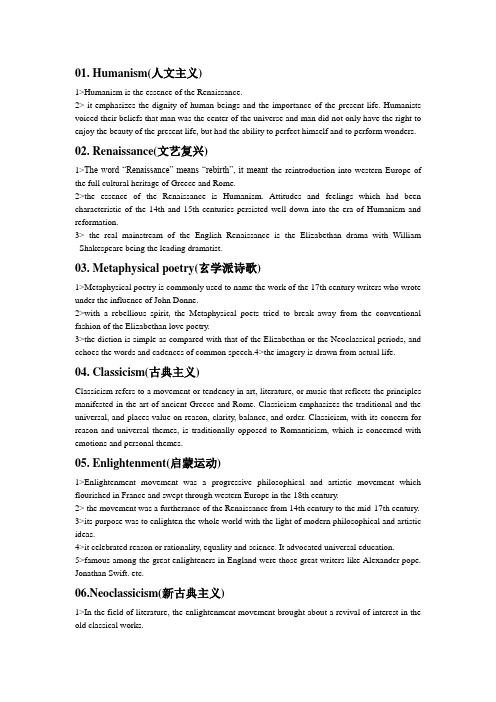
01. Humanism(人文主义)1>Humanism is the essence of the Renaissance.2> it emphasizes the dignity of human beings and the importance of the present life. Humanists voiced their beliefs that man was the center of the universe and man did not only have the right to enjoy the beauty of the present life, but had the ability to perfect himself and to perform wonders.02. Renaissance(文艺复兴)1>The word “Renaissance”means “rebirth”, it meant the reintroduction into western Europe of the full cultural heritage of Greece and Rome.2>the essence of the Renaissance is Humanism. Attitudes and feelings which had been characteristic of the 14th and 15th centuries persisted well down into the era of Humanism and reformation.3> the real mainstream of the English Renaissance is the Elizabethan drama with William Shakespeare being the leading dramatist.03. Metaphysical poetry(玄学派诗歌)1>Metaphysical poetry is commonly used to name the work of the 17th century writers who wrote under the influence of John Donne.2>with a rebellious spirit, the Metaphysical poets tried to break away from the conventional fashion of the Elizabethan love poetry.3>the diction is simple as compared with that of the Elizabethan or the Neoclassical periods, and echoes the words and cadences of common speech.4>the imagery is drawn from actual life.04. Classicism(古典主义)Classicism refers to a movement or tendency in art, literature, or music that reflects the principles manifested in the art of ancient Greece and Rome. Classicism emphasizes the traditional and the universal, and places value on reason, clarity, balance, and order. Classicism, with its concern for reason and universal themes, is traditionally opposed to Romanticism, which is concerned with emotions and personal themes.05. Enlightenment(启蒙运动)1>Enlightenment movement was a progressive philosophical and artistic movement which flourished in France and swept through western Europe in the 18th century.2> the movement was a furtherance of the Renaissance from 14th century to the mid-17th century.3>its purpose was to enlighten the whole world with the light of modern philosophical and artistic ideas.4>it celebrated reason or rationality, equality and science. It advocated universal education.5>famous among the great enlighteners in England were those great writers like Alexander pope. Jonathan Swift. etc.06.Neoclassicism(新古典主义)1>In the field of literature, the enlightenment movement brought about a revival of interest in the old classical works.2>this tendency is known as neoclassicism. The Neoclassicists held that forms of literature were to be modeled after the classical works of the ancient Greek and Roman writers such as Homer and Virgil and those of the contemporary French ones.3> they believed that the artistic ideals should be order, logic, restrained emotion and accuracy, and that literature should be judged in terms of its service to humanity.07. The Graveyard School(墓地派诗歌)1>The Graveyard School refers to a school of poets of the 18th century whose poems are mostly devoted to a sentimental lamentation or meditation on life. Past and present ,with death and graveyard as themes.2>Thomas Gray is considered to be the leading figure of this school and his Elegy written in a country churchyard is its most representative work.08. Romanticism(浪漫主义)1>In the mid-18th century, a new literary movement called romanticism came to Europe and then to England.2>It was characterized by a strong protest against the bondage of neoclassicism, which emphasized reason, order and elegant wit. Instead, romanticism gave primary concern to passion, emotion, and natural beauty.3>In the history of literature. Romanticism is generally regarded as the thought that designates a literary and philosophical theory which tends to see the individual as the very center of all life and experience. 4> The English romantic period is an age of poetry which prevailed in England from 1798 to 1837. The major romantic poets include Wordsworth, Byron and Shelley.09. Byronic Hero(拜伦式英雄)1>Byronic hero refers to a proud, mysterious rebel figure of noble origin.2> with immense superiority in his passions and powers, this Byronic Hero would carry on his shoulders the burden of righting all the wrongs in a corrupt society. And would rise single-handedly against any kind of tyrannical rules either in government, in religion, or in moral principles with unconquerable wills and inexhaustible energies.3> Byron’s chief contribution to English literature is his creation of the “Byronic Hero”10. Critical Realism(批判现实主义)1>Critical Realism is a term applied to the realistic fiction in the late 19th and early 20th centuries.2> It means the tendency of writers and intellectuals in the period between 1875 and 1920 to apply the methods of realistic fiction to the criticism of society and the examination of social issues.3> Realist writers were all concerned about the fate of the common people and described what was faithful to reality.4> Charles Dickens is the most important critical realist.11. Aestheticism(美学主义)1>The basic theory of the Aesthetic movement--- “art for art’s sake” was set forth by a French poet, Theophile Gautier, the first Englishman who wrote about the theory of aestheticism was Walter Pater.2> aestheticism places art above life, and holds that life should imitate art, not art imitate life.3> According to the aesthetes, all artistic creation is absolutely subjective as opposed to objective. Art should be free from any influence of egoism. Only when art is for art’s sake, can it be immortal. They believed that art should be unconcerned with controversial issues, such as politics and morality, and that it should be restricted to contributing beauty in a highly polished style.4> This is one of the reactions against the materialism and commercialism of the Victorian industrial era, as well as a reaction against the Victorian convention of art for morality’s sake, or art for money’s sake.美学运动的基本原则”为艺术而艺术”最初由法国诗人西奥费尔.高缔尔提出,英国运用该美学理论的第一人是沃尔特.佩特.美学主义崇尚艺术高于生活,认为生活应模仿艺术,而不是艺术模仿生活.在美学主义看来,所有的艺术创作都是绝对主观而非客观的产物.艺术不应受任何功利的影响,只有当艺术为艺术而创作时,艺术才能成为不朽之作.他们还认为艺术不应只关注一些热点话题如政治和道德问题,艺术应着力于以华丽的风格张扬美.这是对维多利亚工业发展时期物质崇拜的一种回应,也是向艺术为道德或为金钱而服务的维多利亚传统的挑战.12.The Victorian period(维多利亚时期)1>In this period, the novel became the most widely read and the most vital and challenging expression of progressive thought. While sticking to the principle of faithful representation of the 18th century realist novel, novelists in this period carried their duty forward to criticism of the society and the defense of the mass.2> although writing from different points of view and with different techniques, they shared one thing in common, that is, they were all concerned about the fate of the common people. They were angry with the inhuman social institutions, the decaying social morality as represented by the money-worship and Utilitarianism, and the widespread misery, poverty and injustice.3>their truthful picture of people’s life and bitter and strong criticism of the society had done much in awakening the public consciousness to the social problems and in the actual improvement of the society.4> Charles Dickens is the leading figure of the Victorian period.13. Modernism(现代主义)1>Modernism is comprehensive but vague term for a movement , which begin in the late 19th century and which has had a wide influence internationally during much of the 20th century.2> modernism takes the irrational philosophy and the theory of psycho-analysis as its theoretical case.3> the term pertains to all the creative arts. Especially poetry, fiction, drama, painting, music and architecture.4> in England from early in the 20th century and during the 1920s and 1930s, in America from shortly before the first world war and on during the inter-war period, modernist tendencies were at their most active and fruitful.5>as far as literature is concerned, Modernism reveals a breaking away from established rules, traditions and conventions. fresh ways of looki ng at man’s position and function in the universe and many experiments in form and style. It is particularly concerned with language and how to use it and with writing itself.14. Stream of consciousness(意识流)(or interior monologue)In literary criticism, Stream of consciousness denotes a literary technique which seeks to describe an individual’s point of view by giving the written equivalent of the character’s thought processes. Stream of consciousness writing is strongly associated with the modernist movement. Its introduction in the literary context, transferred from psychology, is attributed to May Sinclair. Stream of consciousness writing is usually regarded as a special form of interior monologue and is characterized by associative leaps in syntax and punctuation that can make the prose difficult to follow, tracing as they do a character’s fragmentary thoughts and sensory feelings. Famous writers to employ this technique in the English language include James Joyce and William Faulkner.学术界认为意识流是一种通过直接描述人物思维过程来寻求个人视角的文学写作技巧。
英美文学名词解释
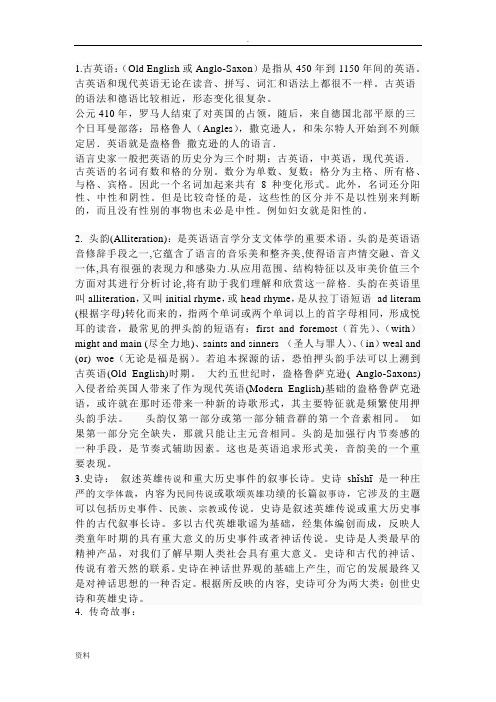
1.古英语:(Old English或Anglo-Saxon)是指从450年到1150年间的英语。
古英语和现代英语无论在读音、拼写、词汇和语法上都很不一样。
古英语的语法和德语比较相近,形态变化很复杂。
公元410年,罗马人结束了对英国的占领,随后,来自德国北部平原的三个日耳曼部落:昂格鲁人(Angles),撒克逊人,和朱尔特人开始到不列颠定居.英语就是盎格鲁_撒克逊的人的语言.语言史家一般把英语的历史分为三个时期:古英语,中英语,现代英语.古英语的名词有数和格的分别。
数分为单数、复数;格分为主格、所有格、与格、宾格。
因此一个名词加起来共有8种变化形式。
此外,名词还分阳性、中性和阴性。
但是比较奇怪的是,这些性的区分并不是以性别来判断的,而且没有性别的事物也未必是中性。
例如妇女就是阳性的。
2. 头韵(Alliteration):是英语语言学分支文体学的重要术语。
头韵是英语语音修辞手段之一,它蕴含了语言的音乐美和整齐美,使得语言声情交融、音义一体,具有很强的表现力和感染力.从应用范围、结构特征以及审美价值三个方面对其进行分析讨论,将有助于我们理解和欣赏这一辞格. 头韵在英语里叫alliteration,又叫initial rhyme,或head rhyme,是从拉丁语短语ad literam (根据字母)转化而来的,指两个单词或两个单词以上的首字母相同,形成悦耳的读音,最常见的押头韵的短语有:first and foremost(首先)、(with)might and main (尽全力地)、saints and sinners (圣人与罪人)、(in)weal and (or) woe(无论是福是祸)。
若追本探源的话,恐怕押头韵手法可以上溯到古英语(Old English)时期。
大约五世纪时,盎格鲁萨克逊( Anglo-Saxons)入侵者给英国人带来了作为现代英语(Modern English)基础的盎格鲁萨克逊语,或许就在那时还带来一种新的诗歌形式,其主要特征就是频繁使用押头韵手法。
英美文学术语解释
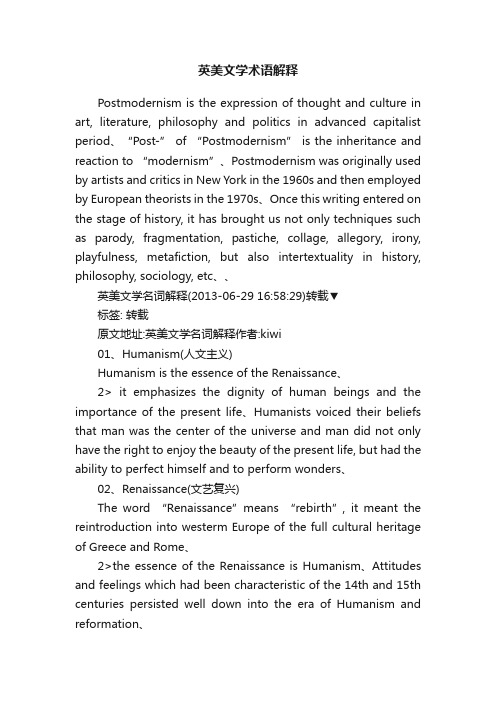
英美文学术语解释Postmodernism is the expression of thought and culture in art, literature, philosophy and politics in advanced capitalist period、“Post-” of “Postmodernism” is the inheritance and reaction to “modernism”、Postmodernism was originally used by artists and critics in New York in the 1960s and then employed by European theorists in the 1970s、Once this writing entered on the stage of history, it has brought us not only techniques such as parody, fragmentation, pastiche, collage, allegory, irony, playfulness, metafiction, but also intertextuality in history, philosophy, sociology, etc、、英美文学名词解释(2013-06-29 16:58:29)转载▼标签: 转载原文地址:英美文学名词解释作者:kiwi01、Humanism(人文主义)Humanism is the essence of the Renaissance、2> it emphasizes the dignity of human beings and the importance of the present life、Humanists voiced their beliefs that man was the center of the universe and man did not only have the right to enjoy the beauty of the present life, but had the ability to perfect himself and to perform wonders、02、Renaissance(文艺复兴)The word “Renaissance”means “rebirth”, it meant the reintroduction into westerm Europe of the full cultural heritage of Greece and Rome、2>the essence of the Renaissance is Humanism、Attitudes and feelings which had been characteristic of the 14th and 15th centuries persisted well down into the era of Humanism and reformation、3> the real mainstream of the english Renaissance is the Elizabethan drama with william shakespeare being the leading dramatist、03、Metaphysical poetry(玄学派诗歌)Metaphysical poetry is commonly used to name the work of the 17th century writers who wrote under the influence of John Donne、2>with a rebellious spirit, the Metaphysical poets tried to break away from the conventional fashion of the Elizabethan love poetry、3>the diction is simple as compared with that of the Elizabethan or the Neoclassical periods, and echoes the words and cadences of common speech、4>the imagery is drawn from actual life、04、Classcism(古典主义)Classcism refers to a movement or tendency in art, literature, or music that reflects the principles manifested in the art of ancient Greece and Rome、Classicism emphasizesthe traditional and the universal, and places value on reason, clarity, balance, and order、Classicism, with its concern for reason and universal themes, is traditionally opposed to Romanticism, which is concerned with emotions and personal themes、05、Enlightenment(启蒙运动)Enlightenment movement was a progressive philosophical and artistic movement which flourished in france and swept through western Europe in the 18th century、2> the movement was a furtherance of the Renaissance from 14th century to the mid-17th century、3>its purpose was to enlighten the whole world with the light of modern philosophical and artistic ideas、4>it celebrated reason or rationality, equality and science、It advocated universal education、5>famous among the great enlighteners in england were those great writers like Alexander pope、Jonathan swift、etc、06、Neoclassicism(新古典主义)In the field of literature, the enlightenment movement brought about a revival of interest in the old classical works、2>this tendency is known as neoclassicism、The Neoclassicists held that forms of literature were to be modeled after the classical works of the ancient Greek and Roman writers such as Homer and Virgil and those of the contemporary French ones、3> they believed that the artistic ideals should be order, logic, restrained emotion and accuracy, and that literature should be judged in terms of its service to humanity、07、The Graveyard School(墓地派诗歌)The Graveyard School refers to a school of poets of the 18th century whose poems are mostly devoted to a sentimental lamentation or meditation on life、Past and present, with death and graveyard as themes、2>Thomas Gray is considered to be the leading figure of this school and his Elegy written in a country churchyard is its most representative work、08、Romanticism(浪漫主义)1>In the mid-18th century, a new literary movement called romanticism came to Europe and then to England、2>It was characterized by a strong protest against the bondage of neoclassicism, which emphasized reason, order and elegant wit、Instead, romanticism gave primary concern to passion, emotion, and natural beauty、3>In the history of literature、Romanticism is generallyregarded as the thought that designates a literary and philosophical theory which tends to see the individual as the very center of all life and experience、4> The English romantic period is an age of poetry which prevailed in England from 1798 to 1837、The major romantic poets include Wordsworth, Byron and Shelley、09、Byronic Hero(拜伦式英雄)Byronic hero refers to a proud, mysterious rebel figure of noble origin、2> with immense superiority in his passions and powers, this Byronic Hero would carry on his shoulders the burden of righting all the wrongs in a corrupt society、And would rise single-handedly against any kind of tyrannical rules either in government, in religion, or in moral principles with unconquerable wills and inexhaustible energies、3> Byron’s chief contribution to English literature is his creation of the “Byronic Hero”10、Critical Realism(批判现实主义)Critical Realism is a term applied to the realistic fiction in the late 19th and early 20th centuries、2> It means the tendency of writers and intellectuals in the period between 1875 and 1920 to apply the methods of realistic fiction to the criticism of society and the examination of social issues、3> Realist writers were all concerned about the fate of the common people and described what was faithful to reality、4> Charles Dickens is the most important critical realist、11、Aestheticism(美学主义)The basic theory of the Aesthetic movement--- “art for art’s sake” was set forth by a French poet, Theophile Gautier, the first Englishman who wrote about the theory of aestheticismwas Walter Pater、2> aestheticism places art above life, and holds that life should imitate art, not art imitate life、3> According to the aesthetes, all artistic creation is absolutely subjective as opposed to objective、Art should be free from any influence of egoism、Only when art is for art’s sake, can it be immortal、They believed that art should be unconcerned with controversial issues, such as politics and morality, and that it should be restricted to contributing beauty in a highly polished style、4> This is one of the reactions against the materialism and commercialism of the Victorian industrial era, as well as a reaction against the Victorian convention of art for morality’s sake, or a rt for money’s sake、美学运动的基本原则”为艺术而艺术”最初由法国诗人西奥费尔、高缔尔提出,英国运用该美学理论的第一人就是沃尔特、佩特、美学主义崇尚艺术高于生活,认为生活应模仿艺术,而不就是艺术模仿生活、在美学主义瞧来,所有的艺术创作都就是绝对主观而非客观的产物、艺术不应受任何功利的影响,只有当艺术为艺术而创作时,艺术才能成为不朽之作、她们还认为艺术不应只关注一些热点话题如政治与道德问题,艺术应着力于以华丽的风格张扬美、这就是对维多利亚工业发展时期物质崇拜的一种回应,也就是向艺术为道德或为金钱而服务的维多利亚传统的挑战、12、The Victorian period(维多利亚时期)In this period, the novel became the most widely read and the most vital and challenging expression of progressive thought、While sticking to the principle of faithful representation of the 18th century realist novel, novelists in this period carried their duty forward to criticism of the society and the defense of the mass、2> although writing from different points of view and with different techniques, they shared one thing in common, that is, they were all concerned about the fate of the common people、They were angry with the inhuman social institutions, the decaying social morality as represented by the money-worship and Utilitarianism, and the widespread misery, poverty and injustice、3>their truthful picture of people’s life and bitter and stro ng criticism of the society had done much in awakening the public consciousness to the social problems and in the actual improvement of the society、4> Charles Dickens is the leading figure of the Victorian period、13、Modernism(现代主义)Modernism is comprehensive but vague term for a movement , which begin in the late 19th century and which has had a wide influence internationally during much of the 20th century、。
英美文学名词解释
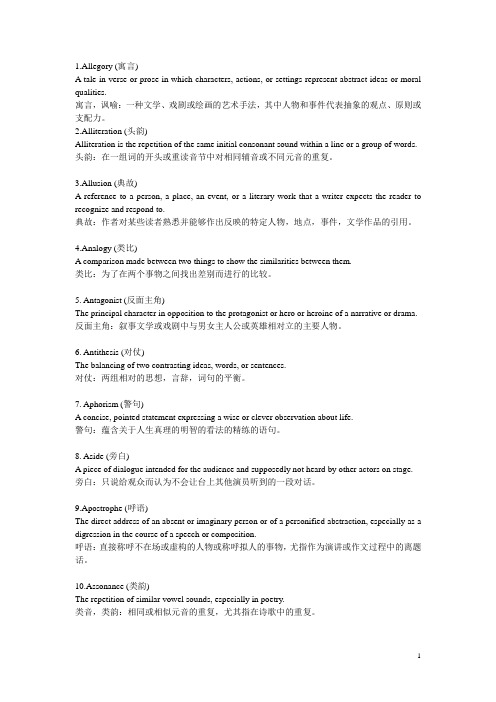
1.Allegory (寓言)A tale in verse or prose in which characters, actions, or settings represent abstract ideas or moral qualities.寓言,讽喻:一种文学、戏剧或绘画的艺术手法,其中人物和事件代表抽象的观点、原则或支配力。
2.Alliteration (头韵)Alliteration is the repetition of the same initial consonant sound within a line or a group of words. 头韵:在一组词的开头或重读音节中对相同辅音或不同元音的重复。
3.Allusion (典故)A reference to a person, a place, an event, or a literary work that a writer expects the reader to recognize and respond to.典故:作者对某些读者熟悉并能够作出反映的特定人物,地点,事件,文学作品的引用。
4.Analogy (类比)A comparison made between two things to show the similarities between them.类比:为了在两个事物之间找出差别而进行的比较。
5. Antagonist (反面主角)The principal character in opposition to the protagonist or hero or heroine of a narrative or drama. 反面主角:叙事文学或戏剧中与男女主人公或英雄相对立的主要人物。
6. Antithesis (对仗)The balancing of two contrasting ideas, words, or sentences.对仗:两组相对的思想,言辞,词句的平衡。
(完整word版)英美文学名词解释总结中文版(东北师大重点)

名词解释1. Abby Theatre 阿贝剧院阿贝剧院是爱尔兰的国家剧院,由爱尔兰著名诗人William Butler Yeats和Lady Augusta Gregory创建。
该剧院上演爱尔兰剧作家的作品。
Lady Gregory是阿贝剧院的导演,同时也是个剧作家(dramatist)。
2。
Aestheticism 唯美主义基本原则:Art for art’s sake.基本人物:英国运用该美学理论的第一人士Walter Pater。
Oscar Wilder(Picture of Dorian Gray)是该理论的杰出代表。
基本思想:唯美主义崇尚艺术高于生活,生活应该模仿艺术,而不是艺术模仿生活。
这是对Victorian工业发展时期宣扬的物质崇拜(materialism)和商业主义(commercialism)的一种反抗,也是艺术为道德或金钱而服务(art for money’s sake)的维多利亚传统的挑战。
3. Age of Enlightenment 启蒙时代1. 英国的18世纪又被称为启蒙时代,总的来说是资本主义反对封建主义的时代.2. 启蒙运动是一场进步的思想运动,盛行于法国后传播到西欧。
3. 启蒙运动是15和16世界文艺复兴运动的延续和深入,它的目的是用现代哲学和艺术观点启蒙整个世界.4。
崇尚理性,平等,和科学,倡导大众教育。
文学在当时变成了非常受欢迎的公众教育的手段,带有强烈的说教和道德教育性质。
5. 代表人物:Alexander Pope,Jonathan Swift.4. Age of Realism现实主义时期1。
现实主义是对浪漫主义时期一种反抗,并铺就了通往现代主义文学的道路。
2。
在这一时期,新一代的作家对于老一辈的浪漫主义和感伤主义的思想非常不满,提出一个新的灵感,其特点就是在生活现实方面有着极大的兴趣.它的目标是描写生活每一方面的现实,抛弃主观偏见,理想主义或者任何浪漫的色彩。
英美文学名词解释
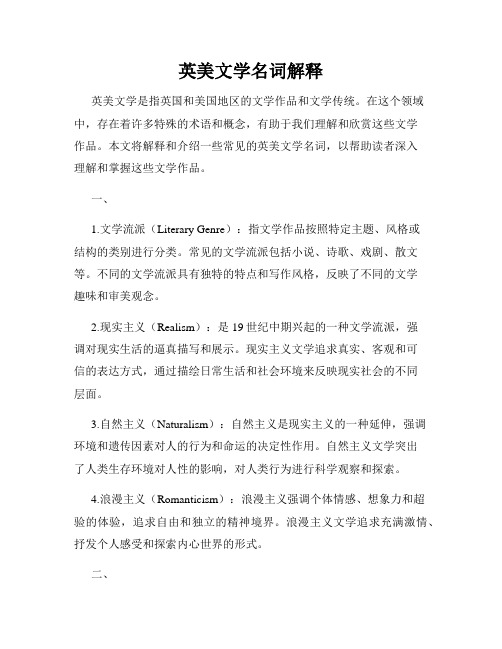
英美文学名词解释英美文学是指英国和美国地区的文学作品和文学传统。
在这个领域中,存在着许多特殊的术语和概念,有助于我们理解和欣赏这些文学作品。
本文将解释和介绍一些常见的英美文学名词,以帮助读者深入理解和掌握这些文学作品。
一、1.文学流派(Literary Genre):指文学作品按照特定主题、风格或结构的类别进行分类。
常见的文学流派包括小说、诗歌、戏剧、散文等。
不同的文学流派具有独特的特点和写作风格,反映了不同的文学趣味和审美观念。
2.现实主义(Realism):是19世纪中期兴起的一种文学流派,强调对现实生活的逼真描写和展示。
现实主义文学追求真实、客观和可信的表达方式,通过描绘日常生活和社会环境来反映现实社会的不同层面。
3.自然主义(Naturalism):自然主义是现实主义的一种延伸,强调环境和遗传因素对人的行为和命运的决定性作用。
自然主义文学突出了人类生存环境对人性的影响,对人类行为进行科学观察和探索。
4.浪漫主义(Romanticism):浪漫主义强调个体情感、想象力和超验的体验,追求自由和独立的精神境界。
浪漫主义文学追求充满激情、抒发个人感受和探索内心世界的形式。
二、1.象征主义(Symbolism):象征主义是19世纪末20世纪初出现的一种文学和艺术运动,强调使用象征性的意象和隐喻来表达深层的情感和思想。
象征主义文学倾向于表达个体的情感体验和心灵探索。
2.现代主义(Modernism):现代主义是20世纪初兴起的一种文学和艺术运动,强调对传统形式和观念的挑战和颠覆。
现代主义文学追求形式上的创新和实验,探索自我意识、哲学思考和社会变革。
3.后现代主义(Postmodernism):后现代主义是现代主义的继承和超越,强调文化多样性、相对主义和戏仿。
后现代主义文学打破传统的叙事和结构规则,以戏仿和颠覆的方式探索权力、真实性和历史观念。
4.现实主义小说(Realistic Novel):现实主义小说以真实的描写和社会批判为特征,通过塑造现实人物的经历和命运来反映社会问题。
英美文学常用术语及解释
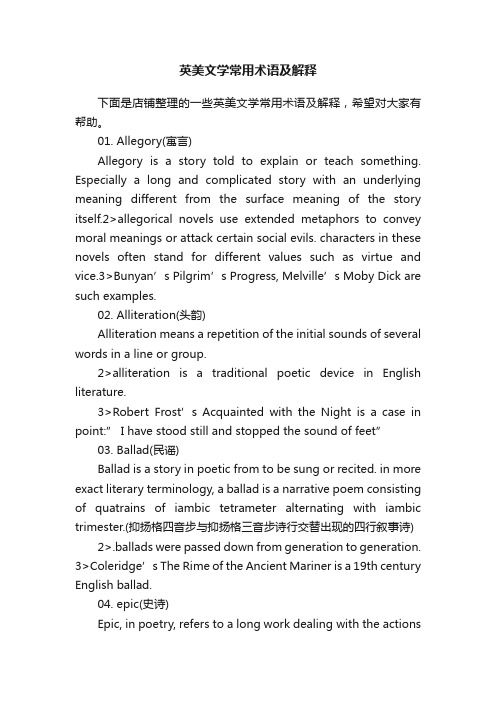
英美文学常用术语及解释下面是店铺整理的一些英美文学常用术语及解释,希望对大家有帮助。
01. Allegory(寓言)Allegory is a story told to explain or teach something. Especially a long and complicated story with an underlying meaning different from the surface meaning of the story itself.2>allegorical novels use extended metaphors to convey moral meanings or attack certain social evils. characters in these novels often stand for different values such as virtue and vice.3>Bunyan’s Pilgrim’s Progress, Melville’s Moby Dick are such examples.02. Alliteration(头韵)Alliteration means a repetition of the initial sounds of several words in a line or group.2>alliteration is a traditional poetic device in English literature.3>Robert Frost’s Acq uainted with the Night is a case in point:” I have stood still and stopped the sound of feet”03. Ballad(民谣)Ballad is a story in poetic from to be sung or recited. in more exact literary terminology, a ballad is a narrative poem consisting of quatrains of iambic tetrameter alternating with iambic trimester.(抑扬格四音步与抑扬格三音步诗行交替出现的四行叙事诗)2>.ballads were passed down from generation to generation.3>Coleridge’s The Rime of the Ancient Mariner is a 19th century English ballad.04. epic(史诗)Epic, in poetry, refers to a long work dealing with the actionsof goods and heroes.2>Epic poems are not merely entertaining stories of legendary or historical heroes; they summarize and express the nature or ideals of an entire nation at a significant or crucial period of its history.3>Beowulf is the greatest national Epic of the Anglo-Saxons.05. Lay(短叙事诗)It is a short poem, usually a romantic narrative, intended to be sung or recited by a minstrel.06. Romance(传奇)Romance is a popular literary form in the medic England.2>it sings knightly adventures or other heroic deeds.3>chivalry is the spirit of the romance.07. Alexandrine(亚历山大诗行)The name is derived from the fact that certain 12th and 13th century French poems on Alexander the Great were written in this meter.2>it is an iambic line of six feet, which is the French heroic verse.08. Blank Verse(无韵诗或素体广义地说)Blank verse is unrhymed poetry. Typically in iambic pentameter, and as such, the dominant verse forms of English dramatic and narrative poetry since the mid-16th century.09. Comedy(喜剧)Comedy is a light form of drama that aims primarily to amuse and that ends happily. Since it strives to provoke smile and laughter, both wit and humor are utilized. In general, the comic effect arises from recognition of some incongruity of speech, action, or character revelation, with intricate plot.10. Essay(随笔)The term refers to literary composition devoted to the presentation of the writer’s own ideas on a topic and generally addressing a particular aspect of the subject. Often brief in scope and informal in style, the essay differs from such fomal forms as the thesis, dissertation or treatise.11. Euphuistic style(绮丽体)Its principle characteristics are the excessive use of antithesis, which is pursued regardless of sense, and emphasized by alliteration and other devices; and of allusions to historical and mythological personages and to natural history drawn from such writers as Plutarch(普卢塔克), Pliny(普林尼), and Erasmus(伊拉兹马斯).2>it is the peculiar style of Euphues(优浮绮斯)12. History Plays(历史剧)History plays aim to present some historical age or character, and may be either a comedy or a tragedy. They almost tell stories about the nobles, the true people in history, but not ordinary people. the principle idea of Shakespeare’s history plays is the necessity for national unity under a mighty and just sovereign.13. Masques or Masks(假面剧)Masques (or Masks) refer to the dramatic entertainments involving dances and disguises, in which the spectacular and musical elements predominated over plot and character. As they were usually performed at court, often at very great expense, many have political overtones.14. Morality plays(道德剧)A kind of medic and early Renaissance drama that presents the conflict between the good and evil through allegorical characters. The characters tend to be personified abstractions of vices and virtues, which can be named as Mercy. Conscience, etc. unlike a mystery or a miracle play, morality play does notnecessarily use Biblical or strictly religious material because it takes place internally and psychologically in every human being.15.Sonnet(十四行诗)It is a lyric poem of 14 lines with a formal or recited and characterized by its presentation of a dramatic or exciting episode in simple narrative form.2>it is one of the most conventional and influential forms of poetry in Europe.3>Shakespeare’s sonnets are well-known.16. Spenserian Stanza(斯宾塞诗节)Spenserian Stanza is the creation of Edmund spenser.2>it refers to a stanza of nine lines, with the first eight lines in iambic pentameter(五音步抑扬格) and the last line in iambic hexameter(六音步抑扬格),rhyming ababbcbcc. 3>Spenser’s the Faerie Queen was written in this kind of stanza.17. Stanza(诗节)Stanza is a group of lines of poetry, usually four or more, arranged according to a fixed plan.2>the stanza is the unit of structure in a poem and poets do not vary the unit within a poem.18. Three Unities(三一原则)Three rules of 16th and 17th century Italian and French drama, broadly adapted from Aristotle’s Poetics<诗学>:2>the unity of time, which limits a play to a single day; the unity of place, which limits a play’s setting in a single location; and the unity of action, which limits a play to a single story line.19. Tragedy(悲剧)In general, a literary work in which the protagonist meets an unhappy or disastrous end. Unlike comedy, tragedy depicts the actions of a central character who is usually dignified or heroic.20.Conceit(奇特比喻)Conceit is a far-fetched simile or metaphor, a literary conceit occurs when the speaker compares two highly dissimilar things.2>conceit is extensively employed in John Donne’s poetry.21.Metar(格律)The word”meter” is derived from the Greek word”metron” meaning”measure”.2>in English when applied to poetry, it refers to the regular pattern of stressed and unstressed syllables.3>the analysis of the meter is called scansion(格律分析)22. University Wits(大学才子)University Wits refer to a group of scholars during the Elizabethan Age who graduated from either oxford or Cambridge. They came to London with the ambition to become professional writers. Some of them later became famous poets and playwrights. They were called” University Wits”23.Foreshadowing(预兆)Foreshadowing, the use of hints or clues in a novel or drama to suggest what will happen next. Writers use Foreshadowing to create interest and to build suspense.method used to build suspense by providing hints of what is to come.24. Soliloquy(独白)Soliloquy, in drama, means a moment when a character is alone and speaks his or her thoughts aloud..2>the line“to be, or no t to be, that is the question”, which begins the famous soliloquy from Shakespeare’s Hamlet.25.Narrative Poem(叙述诗)Narrative Poem refers to a poem that tells a story in verse,2>three traditional types of narrative poems include ballads,epics, metrical romances.3>it may consist of a series of incidents, as John Milton’s paradise lost.26.Robin Hood(罗宾.豪)Robin hood is a legendary hero of a series of English ballads, some of which date from at least the 14th century.2>the character of Robin Hood is many-sided. Strong, brave and intelligent, he is at the same time tender-hearted and affectionate.3>the dominant key in his character is his hatred for the cruel oppression and his love for the poor and downtrodden.4>another feature of Robin’s view is his reverence for the king, Robin Hood was a people’s hero.27. Beowulf(贝奥武甫)Beowulf, a typical example of old English poetry, is regarded as the greatest national epic of t he Anglo-Saxons. 2>the epic describes the exploits of a Scandinavian hero, Beowulf, in fighting against the monster Grendel, his revengeful nother, and a fire-breathing dragon in his declining years. While fight against the dragon, Beowulf was mortally wounded, however, he killed the dragon at the cost of his life, Beowulf is shown not only as a glorious hero but also as a protector of the people.28. Baroque(巴罗克式风格)This is originally a term of abuse applied to 17th century Italian art and that of other countries. It is characterized by the unclassical use of classical forms, in a literary context; it is loosely used to describe highly ornamented verse or prose, abounding in extravagant conceits.这原本是用来指17世纪的意大利艺术和其他国家艺术滥用的一个术语.这种风格主要是指对古典形式的非古典运用.在文学领域,这种风格松散地用来指十分雕饰的,大量运用奇思妙想的诗歌或散文.29. Cavalier poets(骑士派诗人)A name given to supporters of Charles I in the civil war. These poets were not a formal group, but all influenced by Ben Jonson and like him paid little attention to the sonnet. Their lyrics are distinguished by short lines, precise but idiomatic diction, and an urbane and graceful wit.30. Elegy(挽歌)Elegy has typically been used to refer to reflective poems that lament the loss of something or someone, and characterized by their metrical form.31. Restoration Comedy(复辟时期喜剧)Restoration Comedy, also the comedy of manners, developed upon the reopening of the theatres after the re-establishment of monarchy with the return of Charles II.. Its predominant tone was witty, bawdy, cynical, and amoral. Standard characters include fops, bawds, scheming valets, country squires, and sexually voracious young widows and older women. The principle theme is sexual intrigue, either for its own sake or for money.复辟时期的喜剧,又称社会习俗讽刺喜剧,是在查理二世君主复辟后剧院重新开业的基础上发展起来的,其主要的基调是诙谐,淫秽,挖苦和非道德.标准的角色包括花花公子,鸨母,诡计多端的仆人,乡绅,性欲旺盛的年轻寡妇和老女人.主要的主题是奸情,有的是为了性,有的是为了钱.。
(完整word版)英美文学名词解释总结中文版(东北师大重点)

名词解释1. Abby Theatre 阿贝剧院阿贝剧院是爱尔兰的国家剧院,由爱尔兰著名诗人William Butler Yeats和Lady Augusta Gregory创建。
该剧院上演爱尔兰剧作家的作品。
Lady Gregory是阿贝剧院的导演,同时也是个剧作家(dramatist)。
2。
Aestheticism 唯美主义基本原则:Art for art’s sake.基本人物:英国运用该美学理论的第一人士Walter Pater。
Oscar Wilder(Picture of Dorian Gray)是该理论的杰出代表。
基本思想:唯美主义崇尚艺术高于生活,生活应该模仿艺术,而不是艺术模仿生活。
这是对Victorian工业发展时期宣扬的物质崇拜(materialism)和商业主义(commercialism)的一种反抗,也是艺术为道德或金钱而服务(art for money’s sake)的维多利亚传统的挑战。
3. Age of Enlightenment 启蒙时代1. 英国的18世纪又被称为启蒙时代,总的来说是资本主义反对封建主义的时代.2. 启蒙运动是一场进步的思想运动,盛行于法国后传播到西欧。
3. 启蒙运动是15和16世界文艺复兴运动的延续和深入,它的目的是用现代哲学和艺术观点启蒙整个世界.4。
崇尚理性,平等,和科学,倡导大众教育。
文学在当时变成了非常受欢迎的公众教育的手段,带有强烈的说教和道德教育性质。
5. 代表人物:Alexander Pope,Jonathan Swift.4. Age of Realism现实主义时期1。
现实主义是对浪漫主义时期一种反抗,并铺就了通往现代主义文学的道路。
2。
在这一时期,新一代的作家对于老一辈的浪漫主义和感伤主义的思想非常不满,提出一个新的灵感,其特点就是在生活现实方面有着极大的兴趣.它的目标是描写生活每一方面的现实,抛弃主观偏见,理想主义或者任何浪漫的色彩。
考研英美文学名词解释

英美文学名词解释Terms in English and American Literature1. Aestheticism/the Aestheticism Movement (唯美主义)A European phenomenon during the middle of the 19th century that had its chief headquarters in France. This movement was introduced to late Victorian England mainly Walter Pater as a reaction against the materialism and mercialism of an industrialized society. It was also a reaction against theVictorian convention of art for morality’s sake, or art for money’s sake. The major tenets of thismovement include the belief in the autonomy of a work of art, the emphasis on craft andartistry--the theory of “art for art’s sake”. The most outstanding Victorian representatives ofthis movement included Oscar Wilde.2. Allegory(寓言)A tale in verse or prose in which characters, actions, or settings represent abstract ideas or moral qualities. An allegory is a story with two meanings, a literal meaning and a symbolic meaning.寓言:用诗歌或散文讲的故事,在这个故事中人物、事件或背景往往代表抽象的概念或道德品质。
英美文学名词解释汉语版

英美文学名词解释汉语版
1. 小说 (Novel): 是一种长篇的虚构故事,通常以人物形象和情节为主要构成要素。
2. 散文 (Prose): 是一种以自由的、非诗歌形式的文学作品,通常有较为正式的句子结构和逻辑表达方式。
3. 诗歌 (Poetry): 是一种以押韵、节奏和音乐性为特点的文学形式,通常用比喻、象征和意象来表达作者的情感和观点。
4. 戏剧 (Drama): 是一种能够在舞台上演出的文学形式,通常包括对话、角色互动和舞台指导。
5. 悲剧 (Tragedy): 是一种戏剧类型,通常描绘了主角在命运和自身缺陷之间的斗争,并以悲惨结局告终。
6. 喜剧 (Comedy): 是一种戏剧类型,通常以幽默和滑稽情节为特点,旨在给观众带来愉快和欢笑。
7. 叙事诗 (Epic poem): 是一种长篇叙事诗歌,从古代传统英雄故事中派生而来,通常讲述了一个英雄或重大事件的史诗式叙事。
8. 短篇小说 (Short story): 是一种长度较短的虚构故事,通常聚焦于一个具体的事件或角色,呈现出作者的观点或主题。
9. 传记 (Biography): 是一种通过详细描述一个人的生平和事迹来记录他们的生活和成就的文学作品。
10. 自传 (Autobiography): 是一种以作者自己的经历和回忆为基础写成的传记,通常描绘了作者的成长经历和个人观点。
英美文学名词解释
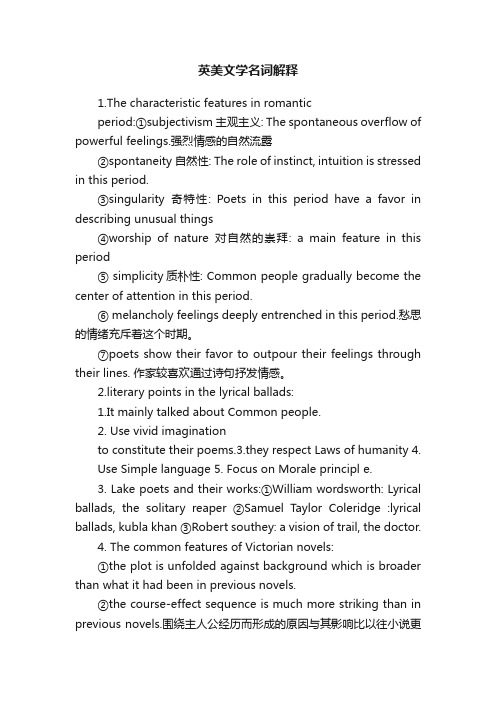
英美文学名词解释1.The characteristic features in romanticperiod:①subjectivism主观主义: The spontaneous overflow of powerful feelings.强烈情感的自然流露②spontaneity自然性: The role of instinct, intuition is stressed in this period.③singularity奇特性: Poets in this period have a favor in describing unusual things④worship of nature对自然的崇拜: a main feature in this period⑤ simplicity质朴性: Common people gradually become the center of attention in this period.⑥ melan choly feelings deeply entrenched in this period.愁思的情绪充斥着这个时期。
⑦poets show their favor to outpour their feelings through their lines. 作家较喜欢通过诗句抒发情感。
2.literary points in the lyrical ballads:1.It mainly talked about Common people.2. Use vivid imaginationto constitute their poems.3.they respect Laws of humanity 4.Use Simple language 5. Focus on Morale principl e.3. Lake poets and their works:①William wordsworth: Lyrical ballads, the solitary reaper ②Samuel Taylor Coleridge :lyrical ballads, kubla khan ③Ro bert southey: a vision of trail, the doctor.4. The common features of Victorian novels:①the plot is unfolded against background which is broader than what it had been in previous novels.②the course-effect sequence is much more striking than in previous novels.围绕主人公经历而形成的原因与其影响比以往小说更显精彩。
英美文学史名词解释
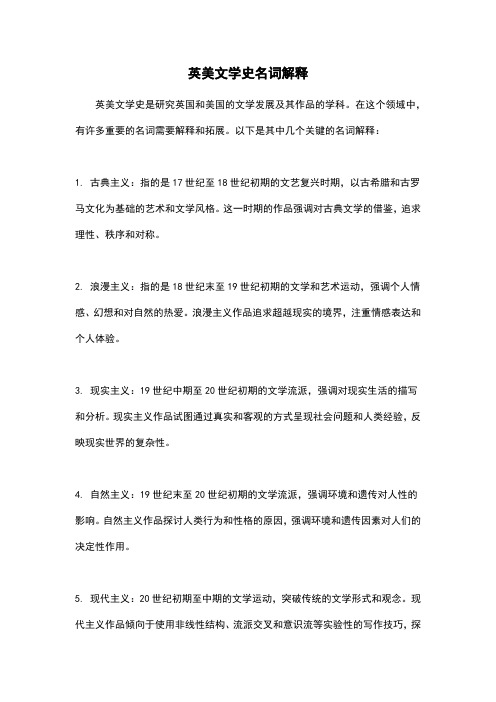
英美文学史名词解释
英美文学史是研究英国和美国的文学发展及其作品的学科。
在这个领域中,有许多重要的名词需要解释和拓展。
以下是其中几个关键的名词解释:
1. 古典主义:指的是17世纪至18世纪初期的文艺复兴时期,以古希腊和古罗马文化为基础的艺术和文学风格。
这一时期的作品强调对古典文学的借鉴,追求理性、秩序和对称。
2. 浪漫主义:指的是18世纪末至19世纪初期的文学和艺术运动,强调个人情感、幻想和对自然的热爱。
浪漫主义作品追求超越现实的境界,注重情感表达和个人体验。
3. 现实主义:19世纪中期至20世纪初期的文学流派,强调对现实生活的描写和分析。
现实主义作品试图通过真实和客观的方式呈现社会问题和人类经验,反映现实世界的复杂性。
4. 自然主义:19世纪末至20世纪初期的文学流派,强调环境和遗传对人性的影响。
自然主义作品探讨人类行为和性格的原因,强调环境和遗传因素对人们的决定性作用。
5. 现代主义:20世纪初期至中期的文学运动,突破传统的文学形式和观念。
现代主义作品倾向于使用非线性结构、流派交叉和意识流等实验性的写作技巧,探
索意识、时间和现代社会的复杂性。
除了这些名词,还有许多其他重要的概念和作品,如文艺复兴、启蒙运动、维多利亚时代、现代派诗歌、战争文学等。
研究英美文学史可以帮助我们了解不同时期的文学发展和作品背后的思想、价值观和文化背景。
英美文学名词解释
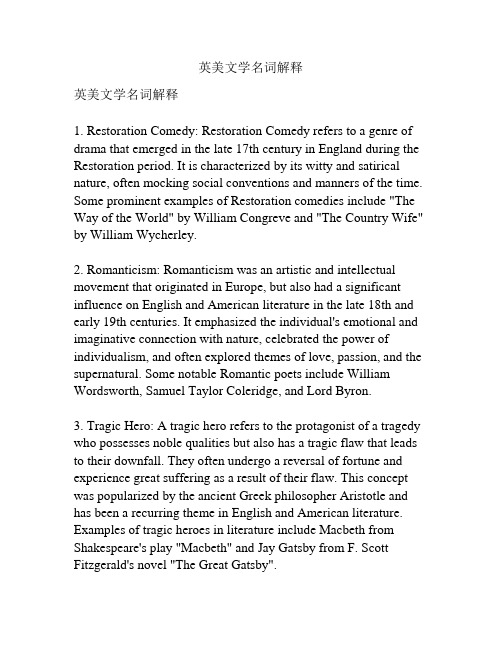
英美文学名词解释英美文学名词解释1. Restoration Comedy: Restoration Comedy refers to a genre of drama that emerged in the late 17th century in England during the Restoration period. It is characterized by its witty and satirical nature, often mocking social conventions and manners of the time. Some prominent examples of Restoration comedies include "The Way of the World" by William Congreve and "The Country Wife" by William Wycherley.2. Romanticism: Romanticism was an artistic and intellectual movement that originated in Europe, but also had a significant influence on English and American literature in the late 18th and early 19th centuries. It emphasized the individual's emotional and imaginative connection with nature, celebrated the power of individualism, and often explored themes of love, passion, and the supernatural. Some notable Romantic poets include William Wordsworth, Samuel Taylor Coleridge, and Lord Byron.3. Tragic Hero: A tragic hero refers to the protagonist of a tragedy who possesses noble qualities but also has a tragic flaw that leads to their downfall. They often undergo a reversal of fortune and experience great suffering as a result of their flaw. This concept was popularized by the ancient Greek philosopher Aristotle and has been a recurring theme in English and American literature. Examples of tragic heroes in literature include Macbeth from Shakespeare's play "Macbeth" and Jay Gatsby from F. Scott Fitzgerald's novel "The Great Gatsby".4. Victorian Novel: Victorian novel refers to a genre of fiction that emerged during the reign of Queen Victoria in the mid to late 19th century in England. It is characterized by its focus on social realism, moral issues, and often emphasized the conflict between individual desires and societal expectations. Prominent Victorian novelists include Charles Dickens, Jane Austen, and the Brontësisters.5. Modernism: Modernism was an artistic and literary movement that emerged in the late 19th and early 20th centuries, primarily in Europe and the United States. It rejected traditional forms and conventions and experimented with new narrative techniques and styles. Modernist literature often explored themes of alienation, fragmentation, and the loss of traditional values in a rapidly changing world. Notable modernist writers include T.S. Eliot, James Joyce, and Virginia Woolf.6. Beat Generation: The Beat Generation was a literary movement that emerged in the 1950s and 1960s in the United States. It was characterized by its rejection of mainstream society and traditional values, and its embrace of nonconformity, spontaneity, and an exploration of alternative forms of spirituality. Prominent Beat Generation writers include Jack Kerouac, Allen Ginsberg, and William S. Burroughs.7. Harlem Renaissance: The Harlem Renaissance was a cultural movement that took place in the 1920s in Harlem, New York, primarily among African American artists, writers, and musicians. It celebrated African American culture and heritage and sought to challenge stereotypes and promote racial pride. Notable writersassociated with the Harlem Renaissance include Langston Hughes, Zora Neale Hurston, and Countee Cullen.These are just a few examples of important literary terms in English and American literature. There are many more that could be explored, each with their own unique contributions to the rich literary traditions of these countries.。
英美文学专有名词及解释
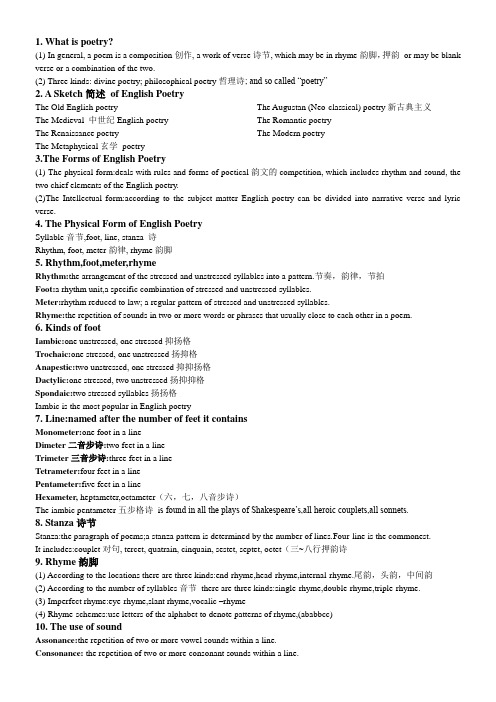
1. What is poetry?(1) In general, a poem is a composition创作, a work of verse诗节, which may be in rhyme韵脚,押韵or may be blank verse or a combination of the two.(2) Three kinds: divine poetry; philosophical poetry哲理诗; and so called “poetry”2. A Sketch简述of English PoetryThe Old English poetryThe Medieval 中世纪English poetry The Renaissance poetryThe Metaphysical玄学poetry The Augustan (Neo-classical) poetry新古典主义The Romantic poetryThe Modern poetry3.The Forms of English Poetry(1) The physical form:deals with rules and forms of poetical韵文的competition, which includes rhythm and sound, the two chief elements of the English poetry.(2)The Intellectual form:according to the subject matter English poetry can be divided into narrative verse and lyric verse.4. The Physical Form of English PoetrySyllable音节,foot, line, stanza 诗Rhythm, foot, meter韵律, rhyme韵脚5. Rhythm,foot,meter,rhymeRhythm:the arrangement of the stressed and unstressed syllables into a pattern.节奏,韵律,节拍Foot:a rhythm unit,a specific combination of stressed and unstressed syllables.Meter:rhythm reduced to law; a regular pattern of stressed and unstressed syllables.Rhyme:the repetition of sounds in two or more words or phrases that usually close to each other in a poem.6. Kinds of footIambic:one unstressed, one stressed抑扬格Trochaic:one stressed, one unstressed扬抑格Anapestic:two unstressed, one stressed抑抑扬格Dactylic:one stressed, two unstressed扬抑抑格Spondaic:two stressed syllables扬扬格Iambic is the most popular in English poetry7. Line:named after the number of feet it containsMonometer:one foot in a lineDimeter二音步诗:two feet in a lineTrimeter三音步诗:three feet in a lineTetrameter:four feet in a linePentameter:five feet in a lineHexameter, heptameter,octameter(六,七,八音步诗)The iambic pentameter五步格诗i s found in all the plays of Shakespeare’s,all heroic couplets,all sonnets.8. Stanza诗节Stanza:the paragraph of poems;a stanza pattern is determined by the number of lines.Four-line is the commonest.It includes:couplet对句, tercet, quatrain, cinquain, sestet, septet, octet(三~八行押韵诗9. Rhyme韵脚(1) According to the locations there are three kinds:end-rhyme,head-rhyme,internal-rhyme.尾韵,头韵,中间韵(2) According to the number of syllables音节there are three kinds:single-rhyme,double-rhyme,triple-rhyme.(3) Imperfect rhyme:eye-rhyme,slant rhyme,vocalic –rhyme(4) Rhyme-schemes:use letters of the alphabet to denote patterns of rhyme,(ababbcc)10. The use of soundAssonance:the repetition of two or more vowel sounds within a line.Consonance: the repetition of two or more consonant sounds within a line.Alliteration:repetition of two or more initial consonant sounds in words within a line.It is popular used in the earliest English literature.11. The use of repetitionRepetition of a single wordRepetition of a phraseRepetition of the whole structure12. The intellectual form of poetryAccording to the subject matter English poetry can be divided into narrative verse and lyric verse.13. Narrative verse叙事诗Epic:great length, a story of heroic action,in dignified 史诗Mock epic:deals with un-heroic matter仿史诗Ballad:a simple, fairly short narrative poem民谣,民歌Fable:a tale conveying some moral truth or a bit of wisdom寓言,童话Didactic poetry:teaching poetry,putting moral,political ,religious point of view教学的诗Satire:similar to didactic,but by the method of attacking words,follies or opposing points of view by ridicule and wit.讽刺Epistle:a letter in verse to friends or famous person书信体诗文14. Lyric verse抒情诗Occasional verse:written to comment a particular event(epithalamium新婚喜歌,elegy挽歌)Ode:a fairly long poem,dignified in style,addressed to some solemn public occasion颂诗,颂歌Epigram:very short,crisp poem,witty and often satirical暗含讽刺,usually with a stinging climax讽刺诗,警句Pastoral:presents a setting of country life田园诗Verse drama:large cast,complex plot and multiple settings舞台剧Eclogue:originally a characteristic form of pastoral,of poetic dialogue牧歌,田园诗Verse dialogue: be used to cover a rather wider field of miniature小型的dramaDramatic lyric:a kind of tiny play using a single voice15. Some traditional verse formsBlank verse:a sequence of unrhymed iambic pentameter,the principle form for English poetry.Couplet:a pair of lines,in any meter, rhyming.(heroic couplets;octosyllabics)(相连并押韵的两行诗,对句)Triplet:a group of three lines,in any meter,rhymingQuatrain:any verse of four rhyming linesSonnet:a poem of fourteen iambic pentameter lines,with the particular rhyme-scheme十四行诗Octava rima:eight iambic pentameter rhyming abababccSpenserian stanza:eight iambic pentameters followed by one iambic hexameter and rhyming ababbcbccFree verse:neither regular pattern of rhymes,or a recognizable traditional meter自由诗16. Imagery(1) The terms of imagery and image is to make poetry concrete not abstract,it covers the use of descriptive language to represent objects,actions,feelings,thoughts,ideas,states of mind and any sensory experience.(2) Two main patterns of imagery:a series of images;a single dominant image.17. Rhetorical修辞devices in poetrySimile明喻, Metaphor暗喻, Metonymy换喻,Synecdoche提喻, Apostrophe撇号,所有格符号,省略符号, Personification拟人, Hyperbole夸张, Litotes曲言法, Paradox自相矛盾, Symbolism象征手法,Pun双关, Allusion暗指,典故,影射18.Argument(1) A form of discourse in which reason is used to influence or change people's ideas or actions.(2) Writers practice argument most often when writing nonfiction, particularly essays or speeches.Example: In his famous speech delivered to the House of Burgesses on March 23,1775, Patrick Henry advances the argument that only by armed resistance can the colonies defend themselves against England and gain their liberty. Heconcludes: "I know not what course others may take; but as for me, give me liberty or give me death! "Main Terms in British and American Literature19.Blank Verse(1) Blank verse is one of the principal English verse patterns in which most long English poems are written.(2) It must not be confused with free verse which follows no regular pattern. Blank verse is written in unrhymed iambic pentameter; in other words, it follows two requirements of pattern: a regular line length of five stresses and a rhythm pattern of alternate unstressed and stressed syllables.Example: Look at Frost's "Mending Wall", which is written in blank verse form, and compare it with Whitman's "I Hear America Singing", which is written in free verse.(3)The unrhymed iambic lines of blank verse prove particularly appropriate in treating serious themes, and have been used by many great American and British poets, including William Shakespeare, John Milton, William Cullen Bryant and Robert Frost.20.Caricature夸张讽刺的描绘(1) Writing that exaggerates certain individual qualities of a person and produces a burlesque, ridiculous effect.(2) Caricature, unlike the highest satire讽刺文学, is likely to treat merely personal qualities; although, like satire, it also lends itself to the ridicule 嘲笑,奚落of political, religious and social foibles.小缺点(3)A work of fiction, history, or biography that traffics in excessive distortion扭曲,畸变or exaggeration may be regarded as a caricature.21. Characters and Characterization(1) Characters are persons -- or animals, things, or natural forces presented as persons -- appearing in a short story, novel, play, or narrative poem.(2) Characters are sometimes described as dynamic 动态的or static静态的.(3) Dynamic characters experience some change in personality or attitude. This change is an essential one and usually involves more than a mere change in surroundings or condition.(4) In Nathaniel Hawthorne's The Scarlet Letter, Hester Prynne, for example, undergoes a major change from being rebellious at the beginning of the novel to being submissive and repentant at the end.(5) Static characters remain the same throughout a narrative. They do not develop or change beyond the way in which they are first presented.(6) Keeney, in the previous play, is an example of a static character. His character is the same at the end of the play as it is at the play's beginning: he is a stem, determined man who puts his pride and reputation before the needs of his wife and the other crew members.(7) Characters in a novel are generally more fully developed than those in a short story, for example. Not only does the novelist have room to develop perhaps more than one dynamic character, but he or she may reveal a main character in many different stages of change. Pip, in Charles Dickens' novel Great Expectations, is a character who, in the course of growing up, undergoes important and basic changes in personality and outlook.(8) Characters are sometimes classified as flat or round.(9) Flat characters have only one or two "sides," representing one or two traits. They are often stereotypes that can be summed up in a few words, for example, an "anxious miser" or a "strong, silent type."(10)Round characters are complex and have many "sides" or traits. Their behavior is unpredictable because they are individuals, and their personalities are fully developed and require lengthy analysis.(11)Flat characters, when developed by a skillful writer, may be as impressive as round characters.(12)Characterization refers to the personality a character displays; also, it is the means by which an author reveals that personality.(13) Generally, a writer develops a character in one or more of the following ways: (1) by showing the character acting and speaking; (2) by revealing a physical description of the character; (3) by revealing the character's thoughts; (4) by revealing what other characters think about the character; (5) by commenting directly on the character. The first four methods are indirect methods of characterization. The writer shows or dramatizes the character and allows you to drawyour own conclusions. The writer tells you directly what a character is like.(15)Direct characterization is always supported by indirect techniques, as characters must act or speak if the writer is developing a story. Also, if characters are to be believable, the reader must hear or see, rather than simply be told, what the characters think or feel or do.22. Conflict(1) Conflict is a struggle between two opposing forces or characters in a short story, novel, play, or narrative poem.(2) Conflict can be external or internal, and it can take one of these forms: (1) a person against another person; (2) a person against society; (3) a person against nature; (4) two elements or ideas struggling for mastery within a person 23.Diction措词Diction is a writer's choice of words, particularly for clarity, effectiveness, and precision.A writer's diction can be formal or informal, abstract or concrete.In choosing the right word, writers must think of their subject and their audience.Words that are appropriate in informal dialogue would not always be appropriate in a formal essay.24.Exposition阐述Exposition is the kind of writing that is intended primarily to present information.Exposition is one of the major forms of discourse. Although it is used in fiction as well as nonfiction, the most familiar form it takes is in essays.Exposition is also that part of a play in which important background information is revealed to the audience.In Romeo and Juliet for example, William Shakespeare begins by giving us essential information about the Montagues and the Couplets. He presents the conflict between these two houses before introducing the love story.25.Fable寓言,童话A fable is a short story, often with animals as its characters, which illustrates a moral.The fable is an ancient form, dating back to ancient Greek and Roman times in which appeared two great world-famous fable writers: Aesop and Phaedrus.Another fabulist with a world-wide fame is the 17th century French writer La Fontaine.Among important American fable writers are Ambrose Bierce and George Ade.26.Free VerseFree verse is a kind of poetry that lacks regular meter or pattern and may or may not rhyme.Depending on natural speech rhythms, its lines may be of different lengths and may switch abruptly from one rhythm to another.When used by a skillful poet, free verse displays special rhythms and melodies unlike any traditional poetic forms.Walt Whitman was the first American poet to use free verse extensively, because it is an appropriate form for his liberating view of life and for his poetry that would allow every aspect of life to speak without restraint.He tried to approximate the natural cadences of speech in his poetry, carefully varying the length of his lines according to his intended emphasis.Most traditional poets dislike this form, but it is in fact a very ancient form (the Psalms of the Bible are written in free verse).As Whitman shows, it can be very effective. If this form ignores some elements of poetic structure, it gives greater importance to others, notably repetition and parallel constructions.27.IronyIrony always involves a contrast, a disparity between the expected and the actual.When the irony implies a discrepancy between what is said and what is meant, it is verbal irony, the most familiar kind. Stories often contain other kinds of irony besides verbal irony: whenever we sense a sharp distinction between the ideas or opinions of the narrator of a story and those of the author, we are generally reading a work written from an ironic point of view——especially when the narrator is telling us something that we are clearly expected to doubt or to interpret very differently.Storyteller are sometimes fond of irony of fate (or a cosmic irony) developments that reveal a terrible, distance between what people deserve and what they get, between what is and what ought to be.O. Henry's "The Cop and the Anthem" best exemplifies this kind of irony. The story's surprise ending suggests that some malicious fate is deliberately frustrating human efforts, and the reader's sympathy is aroused.28.NarrationLike description, narration is a part of conversation and writing.Narration is the major technique used in expository writing, such as autobiography.Successful narration must grow out of good observation, to-the-point selection from observation, and clear arrangement of details in logical sequence, which is usually chronological.Narration gives an exact picture of things as they occur."The Dynamo and The Virgin" is a typical narrative. In this writing, Adams tells his story from the third-person point of view. He presents the reader with an objective process of his thinking development stimulated by the two incidents. The readers follow him to the revelation of his thesis, that is, the dynamic theory of history.29.Nonfiction非小说类文学作品Nonfiction refers to any prose narrative that tells about things as they actually happened or that presents factual information about something.Autobiography and biography are among the major forms of nonfiction.The purpose of this kind of writing is to give a presumably accurate accounting of a person's life.Essays are also common forms of nonfiction. They are generally personal observations on some subject.Other kinds of nonfiction include the stories, editorials, and letters to the editor found in newspapers, as well as diaries, journals, and travel literature.Writers of nonfiction use the major forms of discourse: description (an impression of the subject); narration (the telling of the story); exposition (explanatory information); and persuasion (an argument to influence people's thinking).30.PersuasionPersuasion is the type of speaking or writing that is intended to make its audience. adopt a certain opinion or perform an action or do both.Persuasion is one of the major forms of discourse.Modern examples of persuasion include political speeches, television commercials, and newspaper editorials.31.PlotPlot is the first and most obvious quality of a story.Plot is what happens in a story. Unlike life, which is random and unpredictable, the short story will usually be shaped by a chain of events, one leading inevitably to another in a line of rising action to a moment of crisis the climax.In "A Good Man Is Hard to Find”, the grandmother's secret taking of the cat on the journey; her chance thought to visit the old plantation; and the conversation with Red Sammy are all carefully arranged events by the author that combine to advance the plot, and lead to the final tragedy.The outcome of climax we call the denouement, a French word meaning the untangling of a knot.For the reader, the plot is the underlying pattern in a work of fiction; the structural element trait gives it unity and order.For the writer, the plot is the guiding principle of selection and arrangement. The writer will usually add coherence to the plot by signaling to the reader in advance the outcome of the action. We call these hints foreshadowing.When the reader finishes "A Good Man Is Hard to Find", he may realize that actually the outcome is foreshadowed several times in the early episodes.Sometimes the author may interrupt the action in a flashback in order to describe crucial events that occurred earlier.The flashback is one form of exposition, the process of giving the reader necessary information concerning characters and events existing before the action proper of a story begin32. Point of ViewThe vantage point from which an author presents a storyThree basic points of view may be distinguished.Firstly, the omniscient -- the author serves as a seemingly all-knowing maker.Secondly, the third person -- the author chooses a character and the story is related in terms of that character in such a way that the field of vision is confined to him or her alone.Thirdly, first person narrative -- a character in the story may tell the story as he or she experienced it; if the character does not comprehend the implications of what is told, the character is called a "naive narrator".33. RealismRealism is, in the broadest literary sense, fidelity to actuality in its representation; a term loosely synonymous with VERISIMILITUDE.Generally, realists are believers in democracy, and the materials they elect to describe are the common, the average, the everyday.Realists espouse what is essentially a mimetic theory of art, concentrating on the thing imitated and asking for something close to a one-to-one correspondence between the representation and the subject.34. SettingBy the setting of a story we mean its time and place——its geography, era, season, and society.Most writers invoke particular places and particular times, and their stories establish these settings precisely.Precise setting helps to establish the truth of the story, to persuade the reader of the validity of the tale.In "Rip Van Winkle”, by a detailed description of a remote, isolated "little village of great antiquity", Iriving creates a quiet, tranquil, ante-bellum social aura, which may betray his personal dislike of change, revolution and war: on the other hand, this setting prepares readers for the following exotic experience of Rip.Setting can give us information, vital to plot and theme.Often, setting and character will reveal each other.At the start of "A Rose for Emily", Faulkner depicts Emily Grierson's house, once handsome but now "an eyesore among eyesores" surrounded by a gas station. Still standing refusing to yield its old-time horse-and buggy splender to the age of the automobile, the house in "its stubborn and coquettish decay" embodies the character of its owner.In some stories, a writer will seem to draw a setting mainly to evoke atmosphere.The atmosphere is the aura or mood, or the general pervasive feeling aroused by the work which shapes the reader’s attitudes and expectations.Gothic fiction and Edgar Allan Poe's horror stories abound with settings of this kind.35. Simile and MetaphorSimiles and metaphors both are comparisons made between two unlike things.A simile makes the comparison through the use of connecting words such as like, as, than, or resembles.The comparison must be made between two essentially dissimilar things. "Peter is like a dog" is a simile, while "Peter is like his father" is not.Like a simile, a metaphor also points out a resemblance between two unlike things with the intent of giving added meaning to one of them.Unlike a simile, a metaphor does not use a connecting word to state a comparison but identifies the two things as one: "Life is a dream" is an example of metaphor.Sometimes a metaphor is suggested or implied. It does not directly state that one thing is another, different thing. This is called an implied metaphor.See examples in "Success Is Counted Sweetest" ("To comprehend a nectar/requires sorest need.") and in Whitman's "O Captain! My Captain!“Similes and metaphors are two important forms of figures of speech. They are used in virtually all forms of literature. They help make things more vivid, true-to-life and easy to understand.Many poets in this book, such as Dickinson, Frost, and Hughes, like to use metaphors to help express their deep thoughts or complicated ideas.36. The SonnetAs one of the most popular of traditional poetic forms, the sonnet is a lyric poem of fourteen lines written in iambic pentameter, i.e. a meter with five accents in each line.Sonnets may vary in structure and rhyme scheme, but they usually express a single theme or idea.Generally speaking, there are two types of sonnets: the Petrachan or Italian sonnet and the Shakespearean or English sonnet.Originated by Italian poets during the thirteenth century, this poetic form reached perfection a century later in the work of Francesco de Petrarch (Italian poet, 1304 - 1374), thus coming to be known as the Petrarchan or Italian sonnet.When English poets of the sixteenth century discovered Petrarch, they were challenged by the demands the Italian sonnet made upon a poet's artistry. In experimenting with this verse form, they often changed its structure and its original rhyme scheme.The most notable variation of the sonnet was made by William Shakespeare, hence the appearance of the Shakespearean or English sonnet.The Italian sonnet consists of two parts and imposes a rigid rhyme scheme: the first eight-line part is called the octave, with a rhyme scheme of abbaabba; the second six-line part is called the sestet, with a rhyme scheme of cdecde. Generally, the octave presents the poet's subject or raises a question, while the sestet indicates the significance of the subject, or answers the question or resolves the problem posed in the octave.Unlike the Italian sonnet, the English sonnet is made up of three quatrains and a concluding couplet, with the rhyme scheme of abab cdcd efef gg. In the Italian sonnet, the last six lines usually present a comment on or a summary of the argument put forward in the first eight lines, but in the English sonnet, the conclusion is usually given briefly in the final two lines.Many modern poets have experimented with the sonnet form, combining features of the Italian and the English forms or even inventing new patterns.Of the major American poets of the nineteenth century, Longfellow was the one most influenced by European verse patterns.Therefore, when he attempted the sonnet, he had both the Italian and the English tradition to draw upon.It is typical of his interest in Old World literature that he chose the older Italian form but sometimes made some changes, as in "Mezzo Cammin”37. StanzaThe stanza is a structural division of a poem, consisting of a series of verse lines which usually comprise a recurring pattern of meter and rhyme.In traditional English poetry, there are various stanzaic forms containing two, three, four, five, six, seven, eight or nine lines.The two-line stanza form is called the couplet, the best-known being the heroic couplet which is written in iambic pentameter with all end rhyme:So long as men can Breathe or eyes can see,So long lives this, and this gives life to thee.-- William Shakespeare (1564--1616)The three-line stanza is called the triplet.There are two kinds of triplets: one is called tercet, rhyming aaa, bbb, ccc, and so on; the other is adopted from the Italian, called terza rima, with the first and third lines in rhyme and the second supplying the rhyme for the first and third lines of the following stanza and so on to the end,thus having a rhyme scheme of aba, bcb, cdc, etc.Speak gently, Spring, and make no sudden sound;For in my windy valley yesterday I foundNewborn foxes squirming on the ground——Lew Sarett (1888--1954)I wake to sleep, and take waking slow.I feel my fate in what I cannot fear.I learn by going where I have to go.-- Theodore Roethke (1908--1963)The stanza composed of four lines is called the quatrain, which is the most popular of all stanzaic forms. Its rhyme scheme is generally abab, or abcb, but with variations of aabb, or abba.Many poets included in this book like to use this form. "The Yellow Violet" and "To a Waterfowl" selected here both consist of eight quatrains with a rhyme scheme of abab, cdcd, efef, and so forth.The five-line stanza, called tile quintain, is considered by some poets as one of the most musical forms of stanza we possess, because it is capable of almost endless variety, and the proportions of rhymes, three and two, seem especially conducive to harmony. Edgar Allan Poe's "To Helen" and Robert Frost's "The Road Not Taken" are good examples.The six-line stanza, called the sestet, may be made up of three couplets, a quatrain and a couplet, or two triplets. See Poe's "Annabel Lee".The seven-line stanza is called septet, of which the best-known form is the Chaucerian stanza, named after the English poet Geoffrey Chaucer (1340-1400). Its rhyme scheme is ababbcc.The eight-line stanza, or octave, consists either of two quatrains or of a more complex combination of two triplets and a final couplet, with the latter rhyming abababcc. The octave can be either a separate stanza in a poem or the first part of the sonnet (See Longfellow's "Mezzo Cammin" ).The nine-line stanza is called the nonet. Like the septet, the nonet has one notable form known as the Spenserian stanza after the English poet Edmund Spenser (1552-1599), who used it in The Faerie Queene. The Spenserian stanza is made up of eight lines of iambic pentameter and a concluding Alexandrine (one iambic hexameter line), rhyming ababbcbcc. 38. Symbols and SymbolismSymbols are a part of our everyday lives. The eagle is a symbol of America; the skull and crossbones on a bottle is a symbol of poison; and the dove is a symbol of peace.The literary symbol shares something similar. Generally speaking, a symbol is a sign which suggests more than its literal meaning.Literary symbols are of two broad types: the conventional ones and the occasionally coined ones. Certain symbols occur again and again in literature, thus becoming conventional and possessing almost settled symbolic meanings.For instance, roses symbolize love; spring symbolizes life, and winter death; a journey on the road often symbolizes the journey through life. These conventional symbols are easy to recognize and identify. However, in order to convey particular meanings, writers often create their own symbols in their writing. This type of symbols acquires its suggestiveness not only from qualities inherent in itself but also from the way in which it is used in a given work or context.For example, Whitman and Sandburg both use grass in their poems as a symbol to represent nature.In "Mending Wall", Robert Frost seems to be talking about a simple and familiar process--mending a wall with a neighbor in spring. Yet, by the end of the poem, the wall, the neighbor, and the act of mending a wall become symbolic; they come to represent things larger than themselves.Symbolism is especially appropriate for poetry because it enables poets to compress a very complex idea or set of ideas into one image or even one word.Therefore, symbolism is one of the most powerful devices that poets employ in creation.39. Tone and StyleWhatever leads us to infer the author's attitude is called tone.The tone of a speech or a piece of writing can be formal or intimate, outspoken or reticent, abstruse or simple, solemn or playful, angry or loving, serious or ironic.One of the clearest indications of the tone of a story is the style in which it is written.In general, style refers to how speakers or writers say what they say.The style of a particular work or writer maybe analyzed in terms of the characteristic modes of its diction, or choice of words; its sentence structure and syntax; the density and types of its figurative language; the patterns of its rhythm, component sounds, and other formal features, and its rhetorical aims and devices.Mark Twain, for instance, had an uncanny ability to capture the swing and bite of ordinary speech, to reproduce its。
英美文学名词解释总结
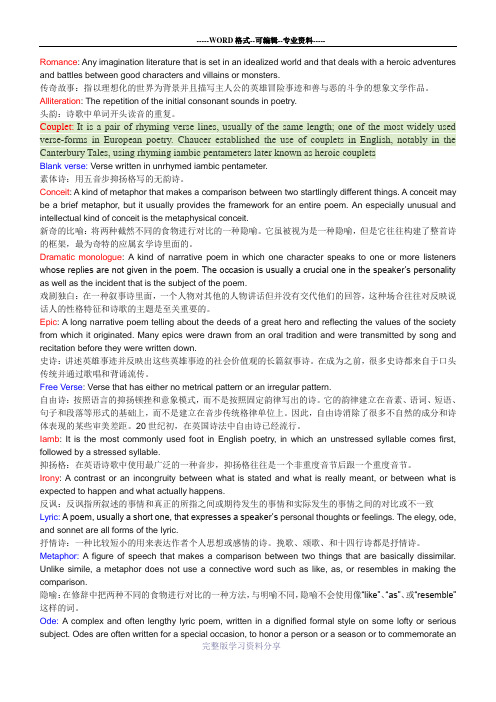
Romance: Any imagination literature that is set in an idealized world and that deals with a heroic adventures and battles between good characters and villains or monsters.传奇故事:指以理想化的世界为背景并且描写主人公的英雄冒险事迹和善与恶的斗争的想象文学作品。
Alliteration: The repetition of the initial consonant sounds in poetry.头韵:诗歌中单词开头读音的重复。
Couplet: It is a pair of rhyming verse lines, usually of the same length; one of the most widely used verse-forms in European poetry. Chaucer established the use of couplets in English, notably in the Canterbury Tales, using rhyming iambic pentameters later known as heroic coupletsBlank verse: Verse written in unrhymed iambic pentameter.素体诗:用五音步抑扬格写的无韵诗。
Conceit: A kind of metaphor that makes a comparison between two startlingly different things. A conceit may be a brief metaphor, but it usually provides the framework for an entire poem. An especially unusual and intellectual kind of conceit is the metaphysical conceit.新奇的比喻:将两种截然不同的食物进行对比的一种隐喻。
考研英美文学名词解释

英美文学名词解释Terms in English and American Literature1. Aestheticism/the Aestheticism Movement (唯美主义)A European phenomenon during the middle of the 19 th century that had its chief headquarters in France. This movement was introduced to late Victorian England mainly Walter Pater as a reaction against the materialism and commercialism of an industrialized society. It was also a reaction against the Victorian convention of art for morality 's sake, or art for money 's sake. The major tenets of this movement include the belief in the autonomy of a work of art, the emphasis on craft and artistry--the theory of “art for art 's sake”. The most outstanding Victorian representatives of this movement included Oscar Wilde.2. Allegory (寓言)A tale in verse or prose in which characters, actions, or settings represent abstract ideas or moral qualities. An allegory is a story with two meanings, a literal meaning and a symbolic meaning. 寓言:用诗歌或散文讲的故事,在这个故事中人物、事件或背景往往代表抽象的概念或道德品质。
- 1、下载文档前请自行甄别文档内容的完整性,平台不提供额外的编辑、内容补充、找答案等附加服务。
- 2、"仅部分预览"的文档,不可在线预览部分如存在完整性等问题,可反馈申请退款(可完整预览的文档不适用该条件!)。
- 3、如文档侵犯您的权益,请联系客服反馈,我们会尽快为您处理(人工客服工作时间:9:00-18:30)。
Literary Terms(文学术语解释)*Legend(传说): A song or narrative handed down from the past, legend differs from myths on the basis of the elements of historical truth they contain.*Epic(史诗): 1)Epic, in poetry, refers to a long work dealing with the actions of gods and heroes. 2)Beowulf is the greatest national epic of the Anglo-Saxons. John Milton wrote three great epics: Paradise Lost, Paradise Regained and Samson Agonistes.*Romance(罗曼史/骑士文学): 1)Romance is a popular literary form in the medieval England. 2)It sings knightly adventures or other heroic deeds. 3)Chivalry(such as bravery, honor, generosity, loyalty and kindness to the weak and poor) is the spirit of romance. *Ballad(民谣): 1)Ballad is a story in poetic form to be sung or recited. 2)Ballads were passed down from generation to generation. 3)Robin Hood is a famous ballad singing the goods of Robin Hood. Coleridge’s The Rime of the Ancient Mariner is a 19th century English ballad.*The Heroic Couplet(英雄对偶句):1)It means a pair of lines of a type once common in English poetry, in other words, it means iambic pentameter rhymed in two lines. 2)The rhyme is masculine. 3)Use of the heroic couplet was first pioneered by Geoffrey Chaucer.*Humanism(人文主义):1)Humanism is the essence of the Renaissance. It emphasizes the dignity of human beings and the importance of the present life. 2)Humanists voiced their beliefs that man was the center of the universe and man did not only have the right to enjoy the beauty of the present life, but had the ability to prefect himself and to perform wonders.*Renaissance(文艺复兴):1)It refers to the transitional period from the medieval to the modern world. It first started in Italy in the 14th century. 2)The Renaissance means rebirth or revival. 3)It was stimulated by a series of historical events, such as the rediscovery of ancient Roman and Greek classics, the new discoveries in geography and astrology, the religious reformation and the economic expansion. 4)Humanism is the essence of Renaissance. 5)The English Renaissance didn’t begin until the reign of Henry Ⅷ. It was reg arded as England’s Golden Age, especially in literature. 6)The real mainstream of the English Renaissance is the Elizabethan drama. 7)This period produced such literary giants as Shakespeare, Spenser, Marlowe, Bacon, Donne and Milton, etc.*University Wits(大学才子): 1)It refers to a group of scholars during the Elizabethan age who graduate from either Oxford or Cambridge. They came to London with the ambition to become professional writers. Some of them later become famous poets and playwrights. 2)Thomas Greene, John Lily and Christopher Marlowe were among them. 3)They paved the way, to some degree, for the coming of Shakespeare.*Blank verse(无韵体):1)It is verse written in unrhymed iambic pentameter. 2)It is the verse form used in some of the greatest English poetry, including that of William Shakespeare and John Milton.*Spenserian Stanza(斯宾塞诗节):1)It is the creation of Edmund Spenser. 2)It refers to a stanza of nine lines, with the first eight lines in iambic pentameter and the last line in iambic hexameter(六音步),r hyming ababbcbcc. 3)Spenser’s The Faerie Queene was written in this kind of stanza.*Sonnet(十四行诗)1)It is the one of the most conventional and influential forms of poetry in English.2)A sonnet is a lyric consisting of 14 lines, usually in iambic pentameter, restricted to a definite rhyme scheme.3)Shakespeare’s sonnets are well-known. *Soliloquy(独白)1)Soliloquy, in drama, means a moment when a character is alone and speaks his or her thoughts aloud. 2)In the line “To be, or not to be, that is the question”, which begins the famous soliloquy from Act3, Scene1 of Shakespeare’s Hamlet. In this soliloquy Hamlet questions whether or not life is worth living and speaks of the reasons why he does not end his life.*Metaphysical Poets(玄学派诗人):They refer to a group of religious poets in the first half of the 17th century whose works were characterized by their wit, imaginative picturing, compressions, often cryptic expression, play of paradoxes and juxtapositions of metaphor.*Enlightenment Movement(启蒙运动)1)It was a progressive intellectual movement which flourished in France and swept through Western Europe in the 18th century.2)The movement was a furtherance of the Renaissance from 14th century to the mid-17th century.3)Its purpose was to enlighten the whole world with the light of modern philosophical and artistic ideas.4)It celebrated reason or nationality, equality and science. It advocated universal education. Literature at the time became a very popular means of public education.5)Famous among the great enlighteners in England were those great writers like John Dryden, Pope, Johnson, Swift, Defoe, Fielding, Sheridan, etc.Neoclassicism(新古典主义)1)In the field of literature, the 18th century Enlightenment Movement brought about a revival of interest in the old classical works. This tendency is known as neoclassicism.2)The neoclassicists hold that forms of literature were to be modeled after the classical works of the ancient Greek and Roman writers such as Homer and Virgil and those of the contemporary French ones.3)They believed that the artistic ideas should be order, logic, restrained emotion and accuracy, and that literature should be judged in terms of its service to humanity*Sentimentalism(感伤主义文学)1)It is a pejorative term to describe false or superficial emotion, assumed feeling, self-regarding postures of grief and pain.2)In literature it denotes overmuch use of pathetic effects and attempts to arouse feeling by pathetic indulgence.3)The Vicar of Wakefield by Oliver Goldsmith is a case in point.*The Graveyard School(墓地派诗歌)1)It refers to a school of poets of the 18th century whose poems are mostly devoted to a sentimental lamentation or meditation on life, past and present, with death and graveyard as theams.2)Thomas Gray is considered to be the leading figure of this school and his Elegy Written in a Country Churchyard is its most representative work.*Epistolary novel(书信体小说)1)It consists of the letters the characters write to each other. The usual form is the letter, but diary entries, newspaper clippings and other documents are sometimes used.2)The epistolary novel’s reliance on subjective poi nts of view makes it the forerunner of the modern psychological novel.3)Samuel Richardson’s Pamela is typical of this kind.*Gothic Romance(哥特传奇)1)A type of novel that flourished in the late 18th and early 19th century in England.2)Gothic romances are mysteries, often involving the supernatural and heavily tinged with horror, and they are usually against dark backgrounds of medieval ruins and haunted castles.*Picaresque novel(流浪汉小说)1)It is a popular sub-genre of prose fiction which is usually satirical and depicts in realistic and often humorous detail the adventures of a roguish hero of low social class who lives by his or her wits in a corrupt society. 2)As indicated by its name, this style of novel originated in Spain, flourished in Europe in the 17th and 18th centuries, and continues to influence modern literature.*English Romanticism(英国浪漫主义文学)1)The English Romantic period is an age of poetry. Poets started a rebellion against the neoclassical literature, which was later regarded as the poetic revolution. They saw poetry as a healing energy; they believed that poetry could purify both individual souls and the society.2)The Lyrical Ballads by Wordsworth and Coleridge in 1798 acts as a manifesto for the English Romanticism.3)The Romantics not only eulogize the faculty of imagination, but also stress the concept of spontaneity and inspiration, regarding them as something crucial for true poetry.4)The natural world comes to the forefront of the poetic imagination. Nature is not only the major source of poetic imagery, but also provides the dominant subject matter.*Ode(颂歌)1)Ode is a dignified and elaborately lyric poem of some length, praising and glorifying an individual, commemorating an event, or describing nature intellectually rather than emotionally.2)John Keats wrote great odes. His Ode on a Grecian Urn is a case in point.*Lake Poets(湖畔派诗人)They refer to such romantic poets as William Wordsworth, Samuel Coleridge and Robert Southey who lived in the Lake District. They came to be known as the Lake School or “Lakers”.*Byronic hero(拜伦式英雄): It refers to a proud, mysterious rebel figure of noble origin. With immense superiority in his passions and powers, this Byronic hero would carry on his shoulders the burden of righting all the wrongs in a corrupt society, and would rise single-handedly against any kind of tyrannical rules either in government, in religion, or in moral principles withunconquerable wills and inexhaustible energies.Terza rima(三行体)1)It is an Italian verse that consists of a series of three-lines stanzas in which the middle line of each stanza rhymes with the first and third lines of the following stanza with the rhyming scheme ab a, bcb, cdc,ded, etc..2)Shelley’s “Ode to the West Wind” is a case in point*Critical Realism(批判现实主义)1)The Critical Realism of the 19th century flourished in the forties and in the beginning of fifties.2)The realists first and foremost set themselves the task of criticizing capitalist society from a democratic viewpoint and delineated the crying contradictions of bourgeois reality. But they did not find a way to eradicate social evils.3)Charls Dickens is the most important critical realist.*Psychological novel(心理小说)1)A vague term to describe that kind of fiction which is for the most part concerned with the spiritual, emotional and mental lives of the characters and with the analysis of characters rather than with the plot and the action.2)Thackeray’s charac terization of Rebecca Sharp is very much psychological.*Narration(叙述)1)Like description, narration is a part of conversation and writing. Narration is the major technique used in expository writing, such as autobiography.2)Successful narration must grow out of good observation, to-the-point selection and clear arrangement of details in logical sequence, which is usually chronological.3)Narration gives an exact picture of things as they occur.*Narrator(叙述者)1)It refers to one who narrates, or tells, a story.2)A story may be told by a first-person narrator, someone who is either a major or minor character in the story. Or a story may be told by a third-person narrator, someone who is not in the story at all.3)The word narrator can also refer to a character in a drama who guides the audience through the play, often commenting on the action and sometimes participating in it.*Plot(情节)1)Plot is the first and most obvious quality of a story. Plot is what happens in a story.2)It consists of the phrases of action in a story that are linked together by a chain of casual relationships.Point of view(叙述角度)1)The event of a story may be told as they appear to one or more participants or observers. In first-person narration the point of view is automatically that of the narrator.2)More variation is possible in third-person narration, where the author may choose to limit his or her report to what could have been observed or known by one of the characters at any given point in the action—or may choose to report the observations and thoughts of several characters. The author might choose to intrude his or her own point of view.*Naturalism(自然主义)1)A post Darwinian movement of the late 19th century that tried to apply the laws of scientific determinism to fiction. 2)The naturalist w ent beyond the realist’s insistence on the objective presentation of the details of everyday life to insist that the materials of literature should be arranged to reflect a deterministic universe in which a person is a biological creature controlled by environment and heredity.3)Major writers include Crane, Dreiser in America; Zola in France ; and Hardy and Gissing in England.*The Aesthetic Movement(唯美主义运动)1)It is a loosely defined movement in literature, fine art, the decorative arts and interior design in later nineteenth-century Britain. 2)It belongs to the anti-Victorian reaction and had post-Romantic roots, and as such anticipates modernism. It took place in the late Victorian Period from around 1868 to 1901, and is generally considered to have ended with the trial of Oscar Wilde (which occurred in 1895).3)The aesthetes believed that art did not have any didactic purpose; it need only be beautiful.Dramatic Monologue(戏剧独白)1)In literature, it refers to the occurrence of a single speaker saying something to a silent audience.2)Robert Browning is My Last Duchess is a typical example in which the duke, speaking to a non-responding audience, reveals not only the reasons for his disapproval of the behavior of his former duchess, but some tyrannical and merciless aspects of his own personality as well.。
